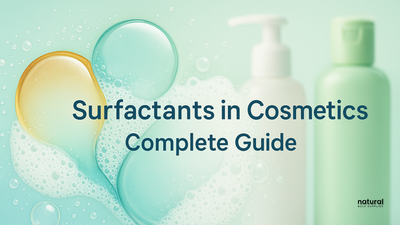Surfactants in Cosmetics: Types, Benefits, and Safety Guide
Posted by Natural Bulk Supplies on on Aug 11th 2025
Surfactants in Cosmetics – Complete Guide
Surfactants are some of the most important ingredients in cosmetic formulations. They make products foam, help oil and water mix, lift away dirt, and improve how a product spreads on the skin or hair. Understanding the basics of surfactants in cosmetics can help in choosing the right type for different skincare and haircare applications.
What Are Surfactants in Cosmetics?
The term surfactant comes from “surface-active agent.” These are compounds that concentrate at the boundary between two substances, such as oil and water, and change the properties of that surface.
In cosmetic and personal care products, surfactants are used to:
-
Remove dirt, oil, and makeup
-
Create foam or lather in shampoos and body washes
-
Keep emulsions stable so oil and water do not separate
-
Improve the spread of creams, lotions, and cleansers
Each surfactant molecule has:
-
A hydrophilic head – attracted to water
-
A hydrophobic tail – attracted to oils and fats
One end binds to oils and impurities, the other connects to water. When rinsed, the unwanted material is carried away.
How Surfactants Work in Skin & Hair Care
Surfactants reduce surface tension, allowing water to spread more evenly instead of forming beads. In water, they form micelles, where the hydrophobic tails point inward and trap oils or dirt, while the hydrophilic heads face outward. When rinsed, these micelles wash away easily, making them highly effective in cleansers and shampoos.
Types of Surfactants in Cosmetics
Surfactants are classified according to the type of charge on the hydrophilic head group. The four main types are:
1. Anionic Surfactants – Cleansing and Foaming Agents
-
Charge: Negative
-
Role: Excellent for removing oils and dirt, producing rich foam
Examples:
-
Sodium Lauryl Sulfate (SLS) – strong cleanser with high foam
-
Sodium Laureth Sulfate (SLES) – milder than SLS, common in shampoos and shower gels
-
Sodium Cocoyl Isethionate (SCI) – gentle, creamy foam, used in syndet shampoo bars and facial cleansers
-
Disodium Laureth Sulfosuccinate – mild, used in baby shampoos and gentle washes
Common Uses: Shampoos, facial cleansers, body washes, foaming gels, cleansing bars
Note: Highly effective cleansers, but strength varies. Milder options are preferred for sensitive skin products.
2. Cationic Surfactants – Conditioning Agents
-
Charge: Positive
-
Role: Adsorb onto hair or skin to provide softness, smoothness, and antistatic properties
Examples:
-
Cetrimonium Chloride – conditioning and detangling
-
Behentrimonium Chloride – rich conditioning in hair masks and cream rinses
-
Stearalkonium Chloride – conditioning and antistatic properties
Common Uses: Hair conditioners, leave-in treatments, cream rinses, some skin lotions
Note: These do not function as cleansers. They are mainly used to condition and protect.
3. Non-Ionic Surfactants – Mild and Versatile
-
Charge: None
-
Role: Gentle cleansers, emulsifiers, and solubilizers
Examples:
-
Decyl Glucoside – mild, plant-derived cleanser
-
Lauryl Glucoside – gentle, adds foam to blends
-
Polysorbate 20 – solubilizes fragrance oils into water-based products
-
Cocamide DEA or Cocamide MEA – foam boosters and thickeners
Common Uses: Baby cleansers, facial washes, makeup removers, creams, lotions, bath oils
Note: Stable in hard water, low irritation, and compatible with most other surfactants.
4. Amphoteric Surfactants – Mild and Foam-Boosting
-
Charge: Can be positive or negative depending on pH
-
Role: Gentle cleansers that improve foam, viscosity, and compatibility with other surfactants
Examples:
-
Cocamidopropyl Betaine – boosts foam and improves mildness
-
Coco Betaine – similar to cocamidopropyl betaine, with slight formulation differences
-
Sodium Cocoamphoacetate – very mild, used in sensitive and baby products
Common Uses: Gentle shampoos, baby washes, facial cleansers, body washes
Note: Often blended with anionic surfactants to improve mildness and foam stability.
How Cosmetic Surfactants Are Produced
Surfactants are made by combining a hydrophobic chain (often from natural oils or synthetic sources) with a hydrophilic head group. This can be done through processes such as:
-
Sulphation/Sulphonation – creates strong anionic cleansers
-
Ethoxylation – improves water solubility and mildness
-
Esterification – produces biodegradable and gentle surfactants
-
Quaternization – creates cationic conditioning agents
Additional refining processes include clarification, deodorization, filtration, blending, and preservation to meet cosmetic quality standards.
Natural and Biodegradable Cosmetic Surfactants
Plant-based surfactants are increasingly popular due to their renewable origin and environmental profile. Examples include:
-
Decyl Glucoside (from corn glucose and coconut oil)
-
Lauryl Glucoside (from glucose and fatty alcohols)
-
Sodium Cocoyl Isethionate (from coconut oil and isethionic acid)
These are biodegradable, mild, and ideal for sensitive skin formulations.
Safety and Handling Guidelines
-
Always follow supplier usage guidelines
-
Wear gloves and goggles when handling concentrated surfactants
-
Adjust pH according to the surfactant’s stability range
-
Combine different surfactants to achieve the desired cleansing, foam, and mildness balance
Frequently Asked Questions (FAQs)
Q1: What are surfactants used for in cosmetics?
They help oil and water mix, remove dirt, and create foam. They are essential in cleansers, shampoos, and many emulsions.
Q2: What are the main types of surfactants?
Anionic (cleansing), Cationic (conditioning), Non-Ionic (gentle and versatile), Amphoteric (mild and foam-boosting).
Q3: Are surfactants safe?
When used within recommended levels, cosmetic-grade surfactants are safe. Stronger surfactants may cause irritation if used too high.
Q4: Can surfactants be natural?
Yes. Plant-derived surfactants such as decyl glucoside and sodium cocoyl isethionate are natural-based and biodegradable.
Q5: Why do some products foam more than others?
Foam level depends on surfactant type, usage rate, formulation pH, and water hardness.
Q6: Do all surfactants clean?
No. Some, such as cationic surfactants, are designed to condition rather than cleanse.
Conclusion
Surfactants are essential to the performance, feel, and stability of many cosmetic products. Choosing the right surfactant or combination will determine how a product cleanses, conditions, foams, and feels after use.
For high-quality surfactants, mild cleansers, and natural cosmetic ingredients, visit Natural Bulk Supplies today.

